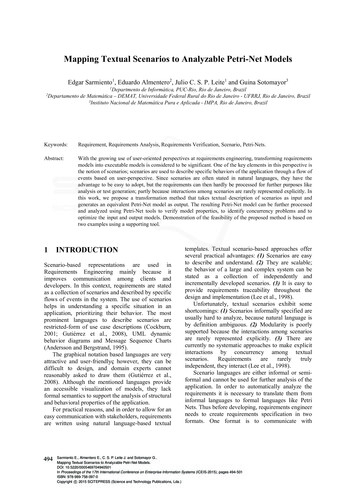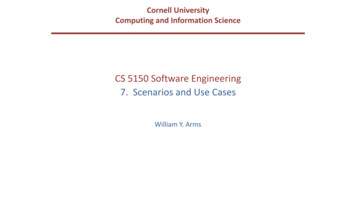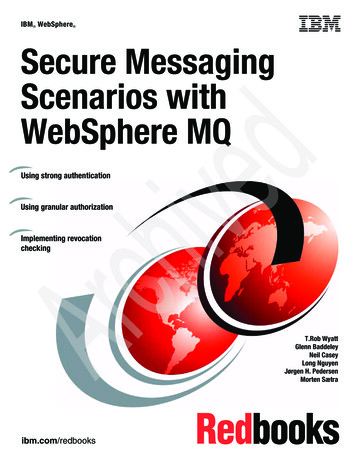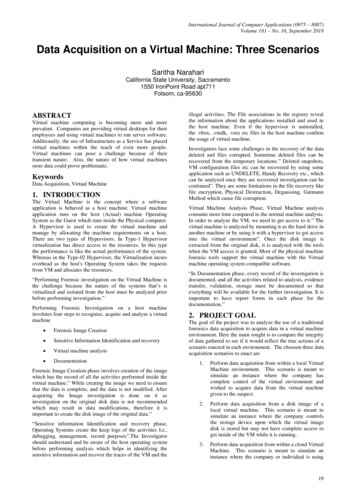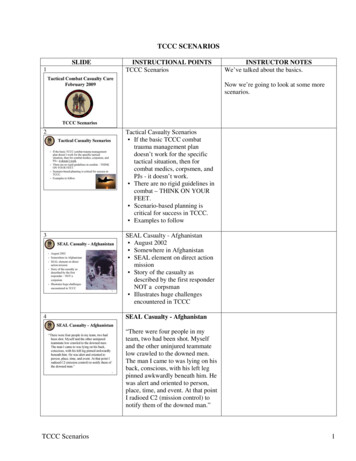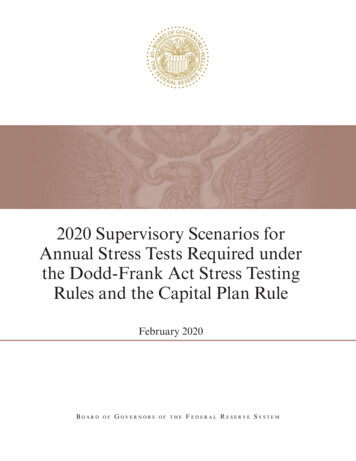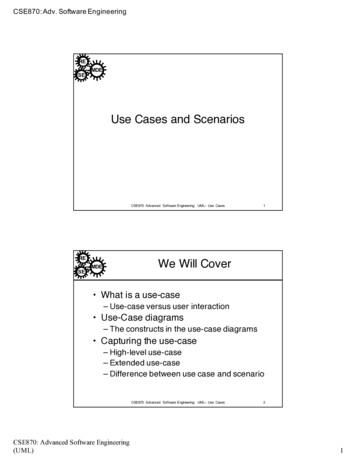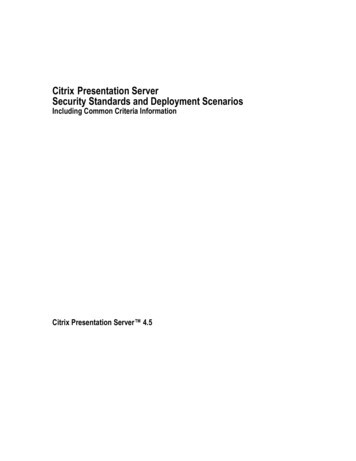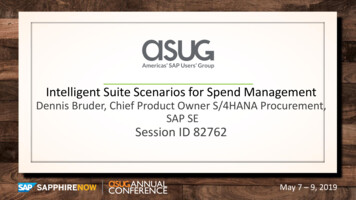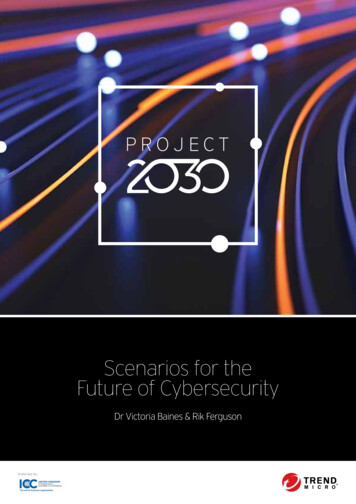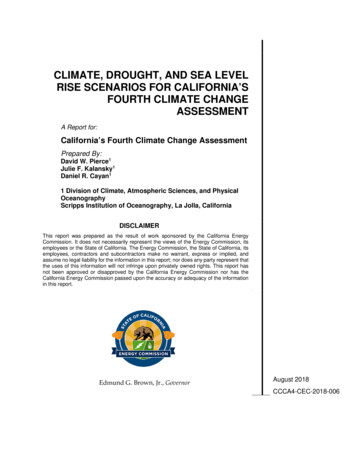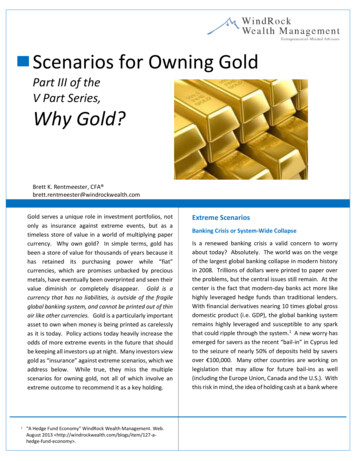
Transcription
Scenarios for Owning GoldPart III of theV Part Series,Why Gold?Brett K. Rentmeester, CFA brett.rentmeester@windrockwealth.comGold serves a unique role in investment portfolios, notonly as insurance against extreme events, but as atimeless store of value in a world of multiplying papercurrency. Why own gold? In simple terms, gold hasbeen a store of value for thousands of years because ithas retained its purchasing power while “fiat”currencies, which are promises unbacked by preciousmetals, have eventually been overprinted and seen theirvalue diminish or completely disappear. Gold is acurrency that has no liabilities, is outside of the fragileglobal banking system, and cannot be printed out of thinair like other currencies. Gold is a particularly importantasset to own when money is being printed as carelesslyas it is today. Policy actions today heavily increase theodds of more extreme events in the future that shouldbe keeping all investors up at night. Many investors viewgold as “insurance” against extreme scenarios, which weaddress below. While true, they miss the multiplescenarios for owning gold, not all of which involve anextreme outcome to recommend it as a key holding.1“A Hedge Fund Economy” WindRock Wealth Management. Web.August 2013 nd-economy .Extreme ScenariosBanking Crisis or System-Wide CollapseIs a renewed banking crisis a valid concern to worryabout today? Absolutely. The world was on the vergeof the largest global banking collapse in modern historyin 2008. Trillions of dollars were printed to paper overthe problems, but the central issues still remain. At thecenter is the fact that modern-day banks act more likehighly leveraged hedge funds than traditional lenders.With financial derivatives nearing 10 times global grossdomestic product (i.e. GDP), the global banking systemremains highly leveraged and susceptible to any sparkthat could ripple through the system.1 A new worry hasemerged for savers as the recent “bail-in” in Cyprus ledto the seizure of nearly 50% of deposits held by saversover 100,000. Many other countries are working onlegislation that may allow for future bail-ins as well(including the Europe Union, Canada and the U.S.). Withthis risk in mind, the idea of holding cash at a bank where
it earns 0% and could someday be seized makes goldheld outside of the banking system an increasinglyattractive alternative for concerned savers. As theentiredeveloped world continues to print money tomanipulate markets higher in the absence of healthyorganic growth, the risks of a systematic global bankingcrisis continue to rise. However, we believe that policymakers looked over the cliff of a global banking crisis in2008 and decided they would print as much money asnecessary to avoid that fate. Thus, events moving uscloser to a banking crisis actually increase the odds forthe opposite outcome – that policy makers print evenmore money, aiding the banks, but panicking investorsabout inflation.French Revolution to restore faith. He stated “while I liveI will never resort to irredeemable paper.”2 In ouropinion, policy makers would only take this action in aworst-case scenario where they have lost control of thesystem. As we discussed in our earlier pieces, re-backingthe dollar with gold (as an example) at ratios similar tothe 1930s could propel gold upwards of 8,000 perounce.3Loss of Faith in CurrenciesIf one extreme is a banking crisis and corresponding creditcrunch, then the other extreme is a loss of faith in the fiatmoney system itself, a condition known as“hyperinflation”. History suggests that once centralbanks start printing money of significant magnitude, it isvery hard to reverse course. This is because the effects ofprinted money serve to prop markets up artificially.Ultimately, policy makers get backed into a corner wherethe act of pulling back the support of easy money riskscollapsing the overleveraged system from artificial levels.We believe this is the dilemma policy makers are facingtoday as they have become the buyer of last resort inmany markets. For example, the Federal Reserve is nowCentral banks have one potential “ace in their pocket” ifwe see renewed banking scares, but it is not a card theywant to play. If a banking crisis lies ahead, policy makerswill be desperate to do whatever they can to restore faithin the system. If the printing of money fails to deliverstability, then the reinsertion of gold into the currencysystem could be their Plan B. Napoleon successfullyreinserted gold into the failing currency system during the23White, Andrew Dickson. Fiat Money Inflation in France (New York, NY:D. Appleton Century Company 1933), p. 77.Murenbeeld, Martin. “Gold Monitor” DundeeWealth Inc. Web. 5April 2013. nomicMarket-Commentary/Index.asp . Pg. 4.September, 20132
the buyer of over 90% of all newly issued treasury bonds,which has artificially suppressed interest rates and led toother assets rising on the opium of cheap credit.4 At somepoint, the continued manufacturing of money out of thinair risks hitting a psychological breaking point. Peoplemay suddenly wake up to the reality that newly printedmoney is diminishing the value of their existing money. Ifhistory is a guide, the response is to swap their currencyinto hard or tangible assets as an alternative store ofvalue since these assets are in relatively fixed supplyversus the exploding supply of currency. At this point, therate at which money changes hands in the economy (i.e.,the velocity of money), which has been subdue since2008, suddenly skyrockets and inflation soars. “Notworth a Continental” is a phrase many investors haveheard before, but too few know its historical relevance.America’s Revolutionary War-era currency, theContinental, was issued in an amount equal to one dollar.By 1779, after being overprinted to fund war withEngland, it was worthless.5 Weimar Germany after WorldWar I is the poster child of this risk. They faced plungingtheir economy into a depression by stopping the printingpresses, so they ultimately chose to print more money.For a period of time, it appeared to work. Their actionspropped up the system, reduced unemployment, andgave the appearance of growth, until it ultimately buckledunder its own weight and collapsed. Adam Fergusson, inhis book When Money Dies: The Nightmare of the WeimarCollapse, wrote:Investors today must recognize that we are conductingthe largest monetary experiment in modern history withunknown consequences. We are not suggesting thatthese extreme scenarios are likely outcomes. However,we are suggesting that, in today’s uncertain worlddominated by money printing and governmentmanipulation, these scenarios require a serious level ofunderstanding. Despite shielding their views from theinvestment public at large, our experience suggests thesmartest investment minds speak of these fears behindclosed doors.Moderate ScenariosShortage of Physical GoldThere is compelling evidence suggesting that there is notenough physical gold relative to the amount of papercontracts written on it today. Some reports suggest thatas many as 100 contracts of paper gold exist for every onebar of physical gold.7 To benefit from this, investors donot need an extreme outcome to see the value of goldunlocked, but they do need to own the actual physicalmetal. Many investors think they own gold, but whatthey actually own are paper contracts with no ability toreceive the actual physical gold. Recent actions by globalbanks such as ABN AMRO are early warnings that cracksmay be developing in the gold market. They defaulted ondelivering physical gold to clients who owned it (insteadredeeming them in cash).8 These paper claims dwarf theamount of physical gold that can be found at today’sprices. Paper claims include most precious metals mutualfunds and exchange traded funds (“ETFs”) and gold heldin “unallocated” bank accounts (i.e. those not held in thelegal title of the account holder, but commingled withother investors on the balance sheet of a financialinstitution). Prospectuses of most ETFs allow redemptionMoney is no more than a medium of exchange. Onlywhen it has a value acknowledged by more than oneperson can it be so used. The more general theacknowledgement, the more useful it is. Once no oneacknowledged it, the Germans learnt, their papermoney had no value or use.6456Kruger, Daniel and McCormick, Liz Capo. “Treasury Scarcity to Growas Fed Buys 90% of New Bonds.” Bloomberg. Web. 12 December2012. carcity-to-grow-as-fed-buys-90-of-new-bonds.html .Rothbard, Murray. A History of Money and Banking in the UnitedStates (Auburn, Alabama: Ludwig von Mises Institute, 2002), pgs. 5960.Fergusson, Adam. When Money Dies: The Nightmare of the WeimarCollapse (London: William Kimber: 1975), p. 31278September, 20133Naylor-Leyland, Ned. Cheviot Asset Management. Interview withCNBC Europe. Web. 23 December 2011. 2012 .“Largest Dutch Bank Defaults on Physical Gold Deliveries toCustomers.” Clarity Digital Group LLC d/b/a Examiner.com. Web. 3April 2013. defaults-on-physical-gold-deliveries-to-customers .
in cash to investors. Thus, this could result in an investorbeing redeemed out of their gold holding at aninopportune time well before gold reaches its peak value.The gold market mimics the fractional-reserve bankingsystem in that a small amount of physical gold underliesmany paper claims. As more investors realize this, therecould be a scramble to secure the actual physical gold,driving prices up significantly. Under these conditions,we’d expect a wide premium to develop benefittingphysical gold over paper claims on gold that can’t deliverthe underlying metal. Compounding matters is the factthat gold is commonly leased out by central banks aroundthe world. This makes it hard to accurately analyze whoactually owns the gold as messy international accountingrules allow more than one party to claim the same goldon their respective balance sheets. Leading investmentminds, such as Eric Sprott of Sprott Asset Management,have extensively investigated this issue, posing thequestion, “do western central banks have any gold left?”9We believe there is much less physical gold available thanmeets the eye – at least at today’s prices.suddenly give them a valuable asset to offset many oftheir liabilities. If this is true, the problem is that too fewinvestors will be holding any physical gold at the time tobenefit.Hedge Against InflationWithout having to assume any type of extreme scenario,gold will be a good investment if the world keeps printingmoney to try and solve its problems. We believe they willkeep printing as the lessor of evils. Printing money willlead to a decline in the value of currencies versus gold,stoking inflation as devalued currencies buy fewer goods.This is the number one reason to own gold – as a hedgeagainst central bank risk and the overprinting of money.We believe that irrespective of money printing ahead, thereckless printing since 2008 already makes currencydevaluation versus gold a high probability event.Historical data suggests that inflation often followsmoney supply growth, but with a lag. Since 2008, wehave increased the money supply upwards of 260% in theUS.10 In addition, we are currently printing approximately 1 trillion dollars a year as our long-term liabilitiescontinue to grow out of control. To us, this suggests ahigh risk of inflation ahead at a time when inflationprotected investments are very cheap and unloved byinvestors.The physical shortage will accelerate as more investorsinclude precious metals as a component of theirportfolios. In addition to investor demand, governmentsaround the world continue to increase their holdings ofgold, especially countries like China where goldrepresents only a small portion of their reserves today.For those that doubt the viability of gold as an asset, it isinstructive to see what the governments of countriesbailing out other weaker countries generally require forcollateral – a country’s gold! There is also a camp ofthought suggesting there could even be a hidden gameunderway today, orchestrated by policy makers. Centralbanks may be active in suppressing the price of gold in thepaper derivatives markets as they quietly accumulatephysical gold on the cheap. Some believe that once theyown the majority of physical metal on their balancesheets, they will cease these actions and gold will berevalued suddenly, perhaps over a weekend. This would9In closing, gold is not a one-trick pony. Own gold for thelikely moderate scenarios, but rest assured that gold isthe best asset if we get pushed to the extremes.10Baker, David and Sprott, Eric. “Do Western Central Banks Have AnyGold Left?” Sprott Global Resource Investments Ltd. Web.September 2012. ticle/?id 6590 Casey, Christopher. “Inflation: Why, When, and How Much” WindRockWealth Management. Web. July 2013. uch .September, 20134
About the AuthorBrett K. Rentmeester, CFA , CAIA , MBA is the Presidentand Chief Investment Officer of WindRock WealthManagement (www.windrockwealth.com).Brett founded WindRock Wealth Management to bringtailored investment solutions to investors seeking anedge in an increasingly uncertain world. er@windrockwealth.com.All written content on this site is for information purposesonly. Opinions expressed herein are solely those ofWindRock Wealth Management, LLC. and our editorialstaff. Material presented is believed to be from reliablesources; however, we make no representations as to itsaccuracy or completeness. All information and ideasshould be discussed in detail with your individual adviserprior to implementation.September, 20135
minds, such as Eric Sprott of Sprott Asset Management, have extensively investigated this issue, posing the question, “do western central banks have any gold left?”9 We believe there is much less physical gold available than meets the eye – at least at today’s prices. The
